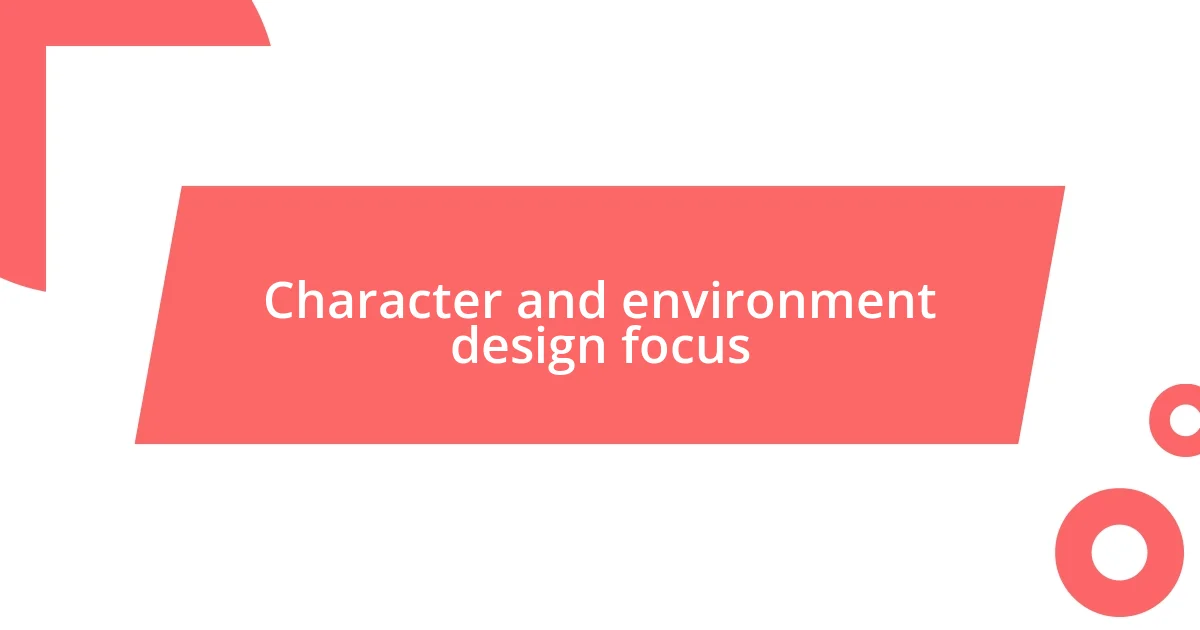Key takeaways:
- Game visuals significantly shape player emotions and experiences, enhancing immersion and narrative connection through elements like color, composition, and design.
- Effective visual storytelling relies on character and environment design, along with lighting techniques, to evoke emotions and tell deeper narratives without dialogue.
- Animation plays a crucial role in gameplay by conveying character emotions and mechanics, enhancing player engagement and providing vital feedback through movement.

Understanding game visuals importance
When I think about game visuals, I’m reminded of the first time I played “Journey.” The stunning art style transported me to another world; I felt emotions I didn’t expect from a video game. Isn’t it fascinating how visuals can shape our experiences, making us feel joy, tension, or even nostalgia?
Visuals create the atmosphere and set the tone, often more than dialogue or gameplay. I sometimes wonder, what if “The Legend of Zelda: Breath of the Wild” had a less vibrant aesthetic? Would it still have captivated fans the same way? I believe that the engaging landscapes and character designs draw players in, making them feel part of a living story.
Moreover, clear visuals can enhance gameplay mechanics. I recall playing a game where the interface was cluttered, making it hard to focus on the action. It’s a reminder that effective game visuals don’t just catch the eye—they guide us, assist us in understanding the game’s world and mechanics. What do you think; have you ever felt overwhelmed or lost due to poor visual design?

Key elements of visual design
When it comes to visual design in games, I prioritize color, composition, and character design. Color choices evoke specific emotions and can influence how players feel about characters and environments. For example, I still remember the eerie green tones in “Limbo,” creating a sense of dread that lingered long after I turned off the console. Composition plays a vital role too; the layout of elements can guide players’ focus and ensure they navigate the game intuitively. It’s intriguing how a well-framed scene can communicate so much without a single word being spoken.
Another essential element to consider is the consistency of visual style. When I play games that maintain a coherent art direction—like “Cuphead,” with its hand-drawn 1930s cartoon aesthetic—I find the experience feels immersive, drawing me into a world that feels meticulously crafted. This consistency helps players understand what to expect, enhancing their connection to the game’s narrative. I often ponder how jarring variations in style might pull players out of the moment; have you noticed a lack of cohesion disrupting your enjoyment in any game?
Lastly, I can’t overlook the impact of UI (User Interface) design on visual effectiveness. A seamless UI can elevate the overall gaming experience by ensuring players easily access critical information without feeling overwhelmed. In an intense match of “Overwatch,” for instance, a clean HUD (Heads-Up Display) allows me to focus on the action without distraction. I feel that when developers invest time in intuitive UI, they demonstrate respect for players’ immersion. Would you agree that a well-thought-out interface can make or break your gaming experience?
| Key Element | Description |
|---|---|
| Color | Evokes emotions and influences player perception of characters and environments. |
| Composition | Affects visual focus and guides player navigation through the game world. |
| Consistency | Maintains a coherent art direction, enhancing immersion and narrative connection. |
| User Interface | Ensures critical information is accessible without overwhelming the player. |

Color theory in game visuals
Color theory plays a pivotal role in game visuals, influencing emotions and gameplay experiences. I often think about how vibrant reds in a game can energize the scene, while cool blues might evoke calm or sorrow. Just the other day, I was immersed in “Inside,” and the stark contrasts of its color palette accentuated the mysteries of the world around me, making every shade feel purposeful. Each color can immediately communicate something profound—whether it’s an impending threat or a serene environment.
- Warm Colors: Often evoke excitement and energy; great for action-packed scenes.
- Cool Colors: Can convey tranquility or sadness; perfect for reflective moments in the game.
- Contrasting Colors: Draw attention to important characters or objects, enhancing player focus.
- Color Harmony: A balanced use of color can create a cohesive visual experience, maintaining immersion.
In my experience, understanding these relationships between colors can tremendously enrich a player’s connection to the game world. For instance, I recall a moment in “Celeste” where the warm sunset colors filled the screen, providing a sense of achievement and hope after overcoming a difficult challenge. It’s remarkable how a simple shift in color can change the mood entirely, bringing depth to gameplay. Do you notice how colors sometimes narrate their own stories?

Character and environment design focus
When I consider character design, I find that every detail matters. The facial expressions and body language tell unspoken stories, drawing players closer to their journey. I recall my experience with “The Last of Us”—the subtle movements of Ellie and Joel conveyed such depth and emotion that I often felt like I was part of their world, sharing in their struggles. Isn’t it fascinating how a well-crafted character can resonate with us long after we’ve finished playing?
Shifting gears to environment design, I’ve learned that the world itself can become a character in its own right. For instance, the haunting beauty of “Shadow of the Colossus” remains etched in my memory, where each vast landscape felt alive with history and lore. The way each area was meticulously crafted allowed me to explore not just physically, but emotionally. How often do you find yourself drawn into the lore of a game just from its visuals?
Understanding the interplay between character and environment is also crucial. In many games, I’ve noticed how the character design complements the setting; think of “BioShock.” The retro-futuristic style of Rapture’s design creates an unsettling backdrop that reflects the moral dilemmas faced by the characters. It’s a reminder that in game design, every visual choice—whether a character’s attire or the surrounding landscape—conveys a deeper narrative. What connections have you made between characters and their environments in the games you’ve played?

Lighting techniques for immersive experiences
Lighting can transform a gaming environment, creating an atmosphere that pulls players deeper into the experience. I experienced this firsthand while playing “Resident Evil 7.” The interplay of shadows and highlights invoked a sense of dread, making me hesitate to explore dark corners, as if something lurked just out of sight. How does lighting shape your emotional responses when you’re gaming?
One technique I often admire is dynamic lighting, where the light sources can change in real-time, affecting the environment. In “The Witcher 3,” I remember wandering through a forest at dusk; as I moved, the sunlight filtered through the trees, shifting and dancing. This ever-changing light made me feel like I was genuinely part of that world, and it highlighted the intricacies of the environment. Isn’t it amazing how such a subtle change can impact the way we perceive a scene?
Moreover, ambient lighting plays an essential role in setting the mood. Think about the soft, warm glows in “Stardew Valley” during the evenings. Those hues made me feel cozy and at home, even in a pixelated world. It’s a testament to how well-executed lighting can evoke comfort or tension, shaping not just visuals, but feelings. Have you found that certain lighting setups linger in your memory long after gameplay?

Animation importance in gameplay
Animation is a crucial element that breathes life into gameplay, allowing players to connect with characters on a deeper level. I remember my first encounter with “Celeste,” where the fluidity of Madeline’s movements not only conveyed her emotions but also made each jump feel exhilarating. Have you ever found yourself cheering for a character simply because their animations represented their determination and struggle?
The subtleties in animation can completely alter the player’s experience. In “God of War,” the way Kratos swings his axe not only looks powerful but feels impactful, enhancing the gameplay dynamics. I often find that when an animation is executed seamlessly, it creates a sense of satisfaction—like when you finally land a perfect combo in a fighting game. When was the last time an animation made you feel invincible while gaming?
Moreover, animations serve to convey vital gameplay mechanics through visual storytelling. When I played “Hollow Knight,” the distinct animations for each enemy not only represented their personality but also indicated their attack patterns, allowing me to strategize effectively. This relationship between animation and gameplay creates a feedback loop that keeps players engaged and informed. Isn’t it fascinating how much information a single animation can communicate?

Tips for effective visual storytelling
Visual storytelling in games thrives on fostering emotional connections through character design. I’ll never forget my first encounter with the beautifully crafted characters in “Ori and the Blind Forest.” Their expressive features and intricate designs fostered an immediate bond, making me feel their joy and sorrow as I navigated the challenges alongside them. Have you ever felt a particular character was almost a mirror of your own emotions?
Another key element is the use of color palettes to evoke specific feelings. I recall vividly the stark contrast in “Inside,” where muted colors set an unsettling tone. As I maneuvered through dark environments, the color choices heightened my sense of unease and curiosity, reflecting the game’s ominous themes. Isn’t it amazing how a simple shift in color can transform a scene’s emotional weight?
Finally, environmental storytelling adds depth to world-building. In “Firewatch,” every item in the wilderness told a story. From abandoned gear to faded photographs, each detail contributed to the narrative, encouraging me to explore and piece together the past. Have you ever found yourself drawn into a game’s world just by the little things scattered throughout? It’s a testament to how visuals can tell intricate stories without a single word.















